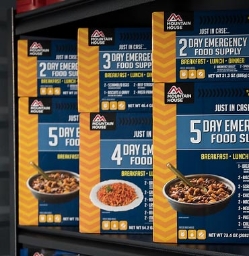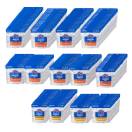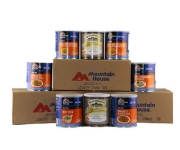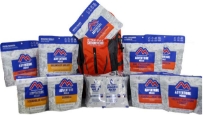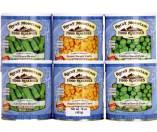Emergency & Hidden Water Sources in Your Home
Posted by Harry Weyandt on Mar 23rd 2020
Emergency & Hidden Water Sources in Your Home
Harry Weyandt
By Harry R Weyandt, Nitro-Pak.Com Preparedness Expert
After a disaster or public emergency, water supply lines may have been broken and become compromised. One of your first priorities is to make sure you secure any water you have in your home for drinking and taking care of basic needs.
Once a disaster has occurred, you’ll need to act quickly to find and safely store as much water in your home as possible so you and your family can make it through the crisis period. The recommendations below are assuming that you have not already put together an emergency water storage plan with water barrels or other containers you have stored away for such uses. If so, the below ideas will be an additional supplement to what you have already stored.
Potentially Your Biggest Water Reserve…Your Bathtub
If advance public warning of an impending disaster such as a major hurricane or tornado has been made, quickly wash and rinse your bathtub(s) of potential contaminates, securely plug the tub drain and fill them fill them full of water. Your bathtub is a huge expedient source for water for you and your family.
As a more sanitary alternative for using your tub for this purpose, a product that I like and was designed for this specific purpose is the AquaPodKit emergency tub liners. They were made to allow you to safely store up to 65 gallons of water in your bathtub in an emergency. This would be enough water for a family of four to cover your basic water needs for 7 to 14 days. The kit also includes a handy hand pump to allow you to pump the water back out afterwards when you need to use it. At under $30, I recommend purchasing one or more of these for your home plus an addition spare liner as a backup.
Other Ways to Store Water Quickly When Disaster Strikes
Again, when possible before a disaster strikes, try to safely secure any water you can in your home by using containers like:
- Kitchen drinking pitchers with lids
- Stock pots with lids
- Plastic kitchen sealed food containers (i.e. Tupperware®, RubberMaid®, etc.)
- Tightly sealed zip-locking plastic bags to fill and seal
Another temporary water storage product that I have used for many years myself as part of my own personal supplies is the Reliance collapsible water carrrier. They come in either a 2.5 or 5 gallon sizes. Personally, I like the smaller size since it only weighs about 20 lbs. when full compared to 40 lbs. for the 5 gallon size.
These are among the best made and perfect for expedient water storing and transportation in an emergency. The on/off spigot makes them convenient for hand washing also. Having a few of these as a part of your emergency supplies is a smart idea whether for in home water collection or when getting and transporting water from other outside water sources like streams, lakes or emergency public water trucks that may be provided.
Shut Down the Water Supply Line to Your Home
After a major earthquake or when you believe any water lines may have been compromised, immediately shut off the water supply to your home. This will prevent any possible contamination from the outside entering the untapped water sources hidden within your home.
Where to Look for Hidden Water Sources in Your Home
Every home has many hidden sources that you may not have considered and could be used in an emergency. Here’s a quick list of possible sources found in most homes.
- WATER HEATERS (access thru the drainage spigot at the bottom of the heater). This is a huge untapped water source. Once cooled, you can have access to 30 to 50 gallons of water per
 heater.
heater. - ..UPPER TANK ONLY if it does not contain bluing or chemical agents. Forget it if it does. Use a cup to scoop out the water into a safe container.
- PIPES IN YOUR HOME. Several gallons residual of water can be found within the water pipes in your home, especially for multi-story homes. Find the lowest water faucet or spigot inside or outside your home or basement. Drain the water directly into a safe storage container as soon as possible (don’t use a hose which may
be contaminated with old water). - REFRIGATOR WATER PITCHERS or other refrigerator beverages.
- FREEZER ICE CUBES or bags of ice in your freezer that have melted and placed in a safe container.
- WATER BOTTLES stored around the home.
- OTHER DRINKABLE LIQUIDS: Draining the liquid from canned vegetables, fruits, tuna, etc. can be used for drinking.
No matter where you may obtain water in an emergency, be prepared to make doubly sure that your water is safe for drinking. If unsure that your water is safe to drink, you will want to filter it, ![]() chemically treat it, boil it or distilling it to insure it is safe.
chemically treat it, boil it or distilling it to insure it is safe.
Other Possible Outside Water Sources
If you are fortunate to live in an area with lakes, natural springs or moving streams, you could filter, chemically treat or boil the water from these sources to make them safe to drink. We cover this more thoroughly in other blog posts.
Water to NEVER USE for Drinking!
Some water should never be used for emergency drinking, even if filtered. DO NOT USE Water from waterbeds, hot tubs spas or swimming pools. This water has been treated with a variety of chemicals like acids, algaecides and other dangerous chemicals that have rendered this water NOT SAFE to drink. You could use spa and swimming pool water for bathing though in an emergency.
Other water sources that should not be considered are public fountains and flood control stream beds that may have unknown chemicals, oils, fuels, bacteria or algae. Be safe and NEVER drink ANY water that is suspect, discolored or has unusual odors. THESE WATERS CANNOT BE MADE SAFE TO DRINK. DON’T RISK IT!
Harry R Weyandt is the founder and owner of Nitro-Pak Preparedness Center Inc., one of America’s oldest and most respected preparedness companies. He has been a leading authority in the preparedness industry for over 30 years and has been interviewed by CNN, ABC News, FOX News, The New York Times, USA Today and The Wall Street Journal among others as an expert in his field. He lives in Utah with this wife Vickie along with their children and grandchildren. His hobbies are boating, camping, international travel and anything to do with preparedness.
